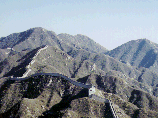
The Great Wall started as earth works thrown up for protection by different States. The individual sections weren't connected until the Qin dynasty (221-206 B.C.). Qin Shihuangdi, First Emperor of Qin began conscripting peasants, enemies, and anyone else who wasn't tied to the land to go to work on the wall. He garrisoned armies at the Wall to stand guard over the workers as well as to defend the northern boundaries. The tradition lasted for centuries. Each dynasty added to the height, breadth, length, and elaborated the design mostly through forced labor.
It was during the Ming dynasty (1368-1644) that the Wall took on its present form. The brick and granite work was enlarged and sophisticated designs were added. The watch towers were redesigned and modern canon were mounted in strategic areas. The Portuguese had found a ready market for guns and canon in China, one of the few items of trade that China didn't already have in abundance. The Ming Emperors, having overthrown the Hun dominance and expelled their Mongol rulers of the North devoted large portions of available material and manpower to making sure that they didn't return.
Throughout the centuries, armies were garrisoned along the length of the Wall to provide early warning of invasion and a first line of defense. Great piles of straw and dung used to build signal fires have been found during excavations. There must have been small garrison towns spotted along the length. There weren't many farms or trade towns to provide ease, relaxation and food. The supply trails were over mountains along narrow paths. To bring supplies to the top, ropes were slung over posts set in the Chinese side of the wall and baskets were hauled up hand over hand. Supplies must have always been short and chancy, particularly in the winter.
The Wall served well. Only when a dynasty had weakened from within were invaders from the north able to advance and conquer. Both the Mongols (Yuan Dynasty, 1271-1368) and the Manchurians (Qing Dynasty,1644-1911) were able take power, not because of weakness in the Wall but because of weakness in the government and the poverty of the people. They took advantage of rebellion from within and stepped into the void of power without extended wars.
Over the past few centuries, the Great Wall has served as a source of building materials for local farms and villages. Aerial photos show that in sections, only the top battlements show -- the center of the wall has filled with sand and silt. The same brutal isolated conditions which made the Great Wall a triumph of engineering and determined planning make restoration problematic and slow.

| Sphinx | Stone Henge | Taj Mahal |
Back to Other Wonders page